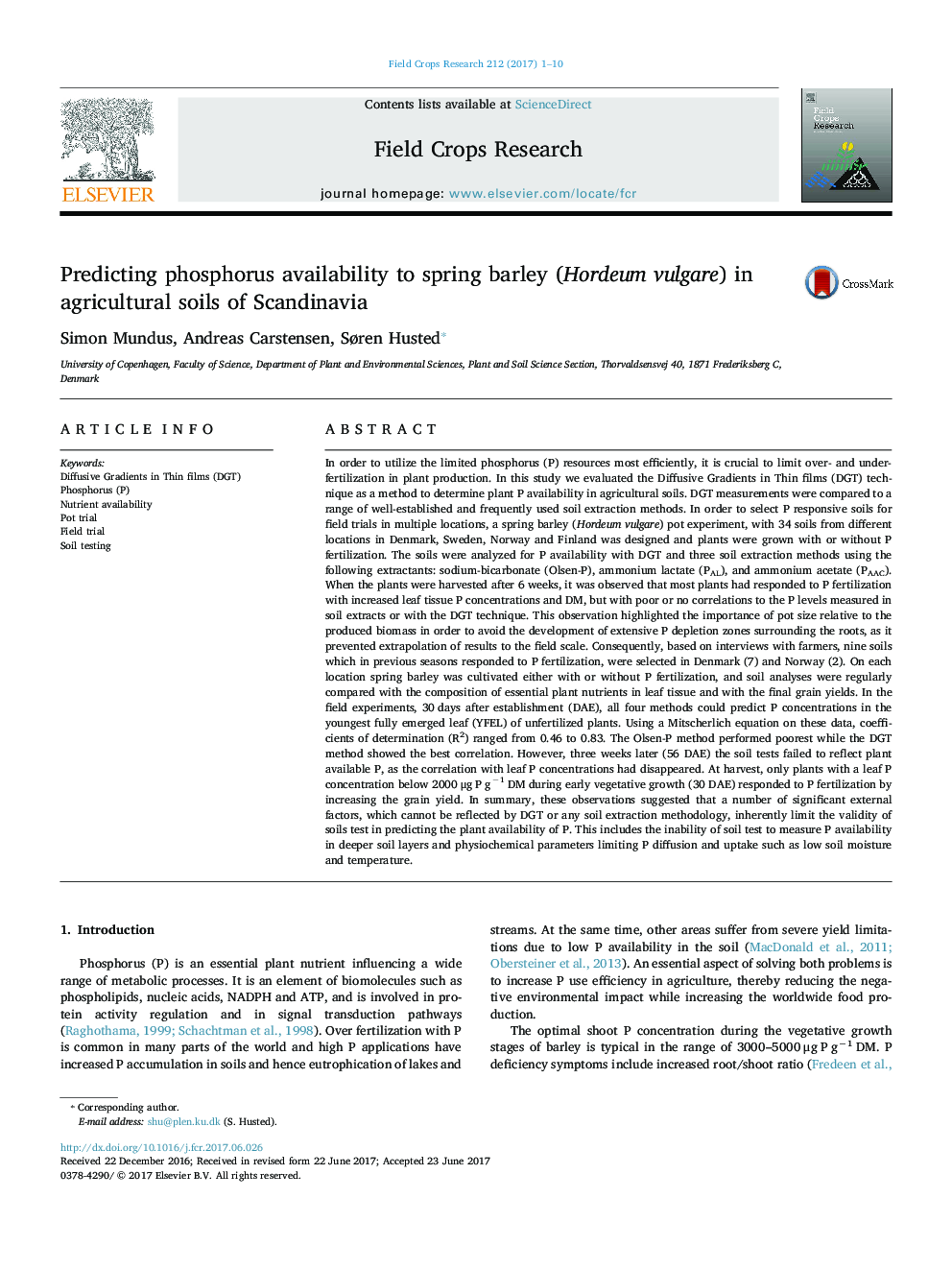| کد مقاله | کد نشریه | سال انتشار | مقاله انگلیسی | نسخه تمام متن |
|---|---|---|---|---|
| 5761341 | 1624651 | 2017 | 10 صفحه PDF | دانلود رایگان |
عنوان انگلیسی مقاله ISI
Predicting phosphorus availability to spring barley (Hordeum vulgare) in agricultural soils of Scandinavia
دانلود مقاله + سفارش ترجمه
دانلود مقاله ISI انگلیسی
رایگان برای ایرانیان
کلمات کلیدی
موضوعات مرتبط
علوم زیستی و بیوفناوری
علوم کشاورزی و بیولوژیک
علوم زراعت و اصلاح نباتات
پیش نمایش صفحه اول مقاله

چکیده انگلیسی
In order to utilize the limited phosphorus (P) resources most efficiently, it is crucial to limit over- and under-fertilization in plant production. In this study we evaluated the Diffusive Gradients in Thin films (DGT) technique as a method to determine plant P availability in agricultural soils. DGT measurements were compared to a range of well-established and frequently used soil extraction methods. In order to select P responsive soils for field trials in multiple locations, a spring barley (Hordeum vulgare) pot experiment, with 34 soils from different locations in Denmark, Sweden, Norway and Finland was designed and plants were grown with or without P fertilization. The soils were analyzed for P availability with DGT and three soil extraction methods using the following extractants: sodium-bicarbonate (Olsen-P), ammonium lactate (PAL), and ammonium acetate (PAAC). When the plants were harvested after 6 weeks, it was observed that most plants had responded to P fertilization with increased leaf tissue P concentrations and DM, but with poor or no correlations to the P levels measured in soil extracts or with the DGT technique. This observation highlighted the importance of pot size relative to the produced biomass in order to avoid the development of extensive P depletion zones surrounding the roots, as it prevented extrapolation of results to the field scale. Consequently, based on interviews with farmers, nine soils which in previous seasons responded to P fertilization, were selected in Denmark (7) and Norway (2). On each location spring barley was cultivated either with or without P fertilization, and soil analyses were regularly compared with the composition of essential plant nutrients in leaf tissue and with the final grain yields. In the field experiments, 30 days after establishment (DAE), all four methods could predict P concentrations in the youngest fully emerged leaf (YFEL) of unfertilized plants. Using a Mitscherlich equation on these data, coefficients of determination (R2) ranged from 0.46 to 0.83. The Olsen-P method performed poorest while the DGT method showed the best correlation. However, three weeks later (56 DAE) the soil tests failed to reflect plant available P, as the correlation with leaf P concentrations had disappeared. At harvest, only plants with a leaf P concentration below 2000 μg P gâ1 DM during early vegetative growth (30 DAE) responded to P fertilization by increasing the grain yield. In summary, these observations suggested that a number of significant external factors, which cannot be reflected by DGT or any soil extraction methodology, inherently limit the validity of soils test in predicting the plant availability of P. This includes the inability of soil test to measure P availability in deeper soil layers and physiochemical parameters limiting P diffusion and uptake such as low soil moisture and temperature.
ناشر
Database: Elsevier - ScienceDirect (ساینس دایرکت)
Journal: Field Crops Research - Volume 212, October 2017, Pages 1-10
Journal: Field Crops Research - Volume 212, October 2017, Pages 1-10
نویسندگان
Simon Mundus, Andreas Carstensen, Søren Husted,